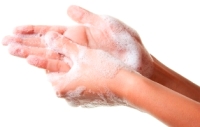Guidelines
BC Guidelines
Provincial Best Practices for Hand Hygiene Guidelines
Published by the BC Ministry of Health, July 2012
(The document has “Appendix 1” at the top as it was originally issued as an Appendix to a Ministry Communiqué)
Notice: The Provincial Best Practices for Hand Hygiene Guidelines are currently being updated. We will notify our community of practice and partners once the resource is revised and approved for publication.
Provincial Best Practices for Hand Hygiene Guidelines: Facilities and Infrastructure Checklist
Published by the BC Ministry of Health, November 2013
(The document has “Appendix 5” at the top as it was originally issued as an Appendix to a Ministry Communiqué)
Guidelines and Resources from Other Jurisdictions
Just Clean Your Hands (JCYH) Program, How to Protect Your Skin, and Four Moments of Hand Hygiene
Created By: Public Health Ontario
December 2023
Hand Hygiene Practices in Health-Care Settings
Created By: Public Health Agency of Canada (PHAC)
March 2012
Hand Hygiene Guidelines
Created By: World Health Organization (WHO)
January 2009
Provincial Hand Hygiene Program
 There is increasing awareness of the importance of hand hygiene (HH), not only to protect patients, but to protect the health and safety of healthcare workers (HCWs). In response to an Office of the Auditor General review on HH programs in healthcare, the Provincial Hand Hygiene Working Group (PHHWG) was formed with the support of the Ministry of Health Services and the BC Health Operations Council.
There is increasing awareness of the importance of hand hygiene (HH), not only to protect patients, but to protect the health and safety of healthcare workers (HCWs). In response to an Office of the Auditor General review on HH programs in healthcare, the Provincial Hand Hygiene Working Group (PHHWG) was formed with the support of the Ministry of Health Services and the BC Health Operations Council.
The Working Group
The PHHWG is composed of representatives from each of the health authorities, the Ministry of Health, and the Provincial Infection Control Network of BC (PICNet).
Aim
The PHHWG group has been tasked with developing a mandatory province-wide hand hygiene program for the health authorities and assisting in its implementation for the individual health authorities. Download the two-page backgrounder.
As an extension sub-group under the PHHWG, the Hand Hygiene Task Group was formed in 2025 with the goal to improve engagement and learning content uptake by revising the Provincial Hand Hygiene Learning Module and create knowledge translation tools to help facilitate implementation of the updated best practices hand hygiene guidance yet to come.
You can read more about the PHHWG and Hand Hygiene Task Group at PICNet’s Committees & Groups page.
Hand Cleaning Compliance (Auditing) Reports
Click here for more information.
Hand Hygiene Resources
Highlighted Hand Hygiene Resources from PICNet:
- Hand Hygiene Basics Course – Online education module through LearningHub
- Hand Care Course – An additional education module on how to take care of your hands and avoid hand dermatitis
- Posters – Click on the ‘Hand Hygiene’ category for posters
- Activities & Games – Hand hygiene related activities can be found here
- Videos – Hand hygiene videos can be found here
- Fact Sheets and Brochures
For more of PICNet’s available resources, see the Resources menu.
